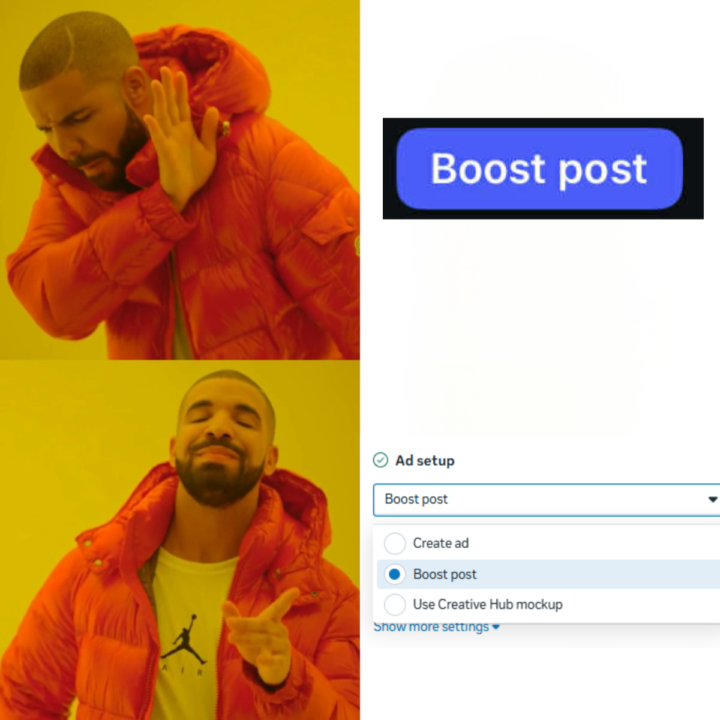Activity
Mon
Wed
Fri
Sun
Jan
Feb
Mar
Apr
May
Jun
Jul
Aug
Sep
Oct
Nov
Dec
What is this?
Less
More
Owned by Wojciech
Start running profitable Meta Ads for your e-commerce business!
Memberships
🇵🇱 Skool IRL: Poland
60 members • Free
Meta Ads Skool
325 members • Free
Educate with Skool
530 members • Free
Skool Money Models
11.6k members • Free
Synthesizer
33.1k members • Free
Skool Growth Free Training Hub
4.2k members • Free
10 contributions to Educate with Skool
How to boost your Instagram post: App vs Ads Manager
If you’ve ever tapped the “Boost post” button on Instagram, you’re not alone. It’s quick, easy, and gives you that sense of "doing marketing." But here’s the thing - boosting directly from the app is one of the most limited ways to run ads. Let’s break down why using Meta Ads Manager is a much smarter move 👇 🚫 Boosting from the Instagram app: You can’t properly choose your campaign objective - everything revolves around engagement or profile visits. Targeting options are extremely limited - mostly interests, age, gender, and location. You don’t get real reporting - no metrics like ROAS, add to cart, or purchase data. On iPhones, it’s even worse - Apple charges a 30% fee on in-app payments when you promote posts directly through Instagram app. This means if you spend $100, only about $70 actually goes to your ads. Using Ads Manager avoids this fee. ✅ Boosting (the right way) from Ads Manager: You can pick a real goal like Sales, Leads, or Traffic. You get full control over audiences - including lookalikes, remarketing, and custom data. You can see detailed performance metrics and actually learn what works. You can connect your Pixel to track conversions and optimize campaigns automatically. And yes, your ads will still appear on Instagram, but they’ll actually work for your goals. If you’re serious about growing your business, Ads Manager isn’t “the complicated way” — it’s the professional way to make every dollar count.
2
0

Here is all you need to track in your Meta Ads Manager
When it comes to Meta Ads for e-commerce, one of the biggest mistakes I see is people checking the wrong numbers. They rely on surface-level data like reach or likes — but those metrics don’t tell you whether your ads are actually making money. That’s why I always use my own Column Preset in Ads Manager — a setup that helps me see real performance at a glance. Here’s what I recommend tracking 👇 1. Budget & Amount Spent – know exactly how much you’re investing and if it matches your plan. 2. Results & Cost per Result – your key outcome (e.g. purchases) and how efficiently you’re achieving it. 3. Impressions, Reach & Frequency – understand how many people see your ads and how often. 4. Link Clicks, CPC & CTR (link click-through rate) – measure how attractive and engaging your ad really is. 5. CPM (cost per 1,000 impressions) – track how expensive your audience is and how competition changes. 6. Website Landing Page Views & Cost per Landing Page View – clicks are one thing, but this tells you if people actually load your site. 7. Add to Cart & Cost per Add to Cart – perfect for spotting if your offer converts attention into buying intent. 8. Purchases, Cost per Purchase & Purchase Conversion Value – your core business metrics. 9. ROAS & Average Purchase Conversion Value – the ultimate view of profitability. Once you create a preset like this, you’ll stop guessing and start optimizing based on real business data — not vanity metrics. What about you? Which metrics do you look at most often when analyzing your campaigns?

Question?
how can i make sure i don't have to accept requests from anyone who wants to join my skool group so they can join directly
My take on the new Meta Andromeda Update
If you’ve been scrolling through marketing groups lately, you’ve probably seen people talking about the new Meta Andromeda Update, and if you believe the hype, it sounds like a complete game-changer. Here’s what most “gurus” are saying right now: - You should simplify everything - one campaign, one ad set, broad targeting, Advantage+ everything. - You should upload at least 50 unique creatives every week (not just different hooks in your reels - completely different videos). - And if you don’t… your performance will drop, CPMs will skyrocket, and your ads will stop working. Sounds dramatic, right? 😅 The thing is, this advice might make sense for giant advertisers who spend big money and can afford to produce endless creatives. But for most small and medium advertisers… it’s just not realistic. Here’s how I see it 👇 Yes, Meta is constantly improving its algorithm. Yes, it’s becoming more dependent on data and automation. But this doesn’t mean you suddenly need 50 unique ads a week to stay competitive. If you’re running ads with smaller budgets (say $10–$50 per day), the algorithm simply won’t have enough money to test that many creatives effectively. You’ll just spread your budget too thin. Instead of chasing every new update, focus on the fundamentals that actually move the needle: ✅ Create a few high quality ads that clearly communicate your offer and resonate with your target audience. ✅ Don't blindly trust every Advantage+ enhancement that you see ✅ Keep your setup simple, but allow yourself to have some control over it To me, the Andromeda update is just another step toward AI-driven advertising, giving Meta more data to automate and optimize performance. I haven’t seen any major drops in results for my clients since it rolled out, so I wouldn’t panic just yet. How about you? Have you noticed any changes in your campaigns since the update? 👇
2
0

3 mindset shifts Meta advertisers need to make
Running Meta Ads isn’t just about learning the platform — it’s about thinking like a player in a competitive game. Here are three mindset shifts that can really help you get better results: 1. Stop expecting the unrealistic - High CPMs? That’s normal if you’re advertising in expensive markets or targeting high-value audiences. - High CAC? Often, the problem isn’t your ads — it’s that your customer's lifetime value (LTV) isn’t high enough to cover the costs. - ROAS always feels too low? If you can’t be profitable with a solid ROAS, it’s worth looking at your overall business model, not blaming the ads performance. 2. You’re buying a ticket to play - Ads don’t come with guaranteed results — they give you a chance to compete in the market. - If a campaign doesn’t work, it’s not the platform’s fault. It’s an opportunity to learn, improve your strategy, and test new approaches. - Your edge comes from experimenting, understanding your audience, and making better ads than your competitors. 3. Ads will keep getting more expensive - Costs on Facebook and Instagram will rise over time — that’s normal. The key is to accept it and keep moving forward. - As it gets harder, some advertisers will quit. Those who keep going have a real advantage. - The most successful advertisers are the ones who stay consistent: testing, creating, and refining campaigns no matter what. If this resonates and you want a place to actually improve your ad skills, join Meta Ads Academy — free for now, paid soon. You’ll get instant access to a video course, an easy-to-follow checklist and support from the community!
1
0

1-10 of 10
@wojciech-maek-7932
Certified Meta Ads Specialist helping entrepreneurs run profitable ads for their businesses. Dog dad 🐶
Active 1d ago
Joined Sep 29, 2025
Poland
Powered by


